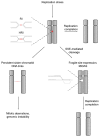Structure-Specific Endonucleases and the Resolution of Chromosome Underreplication
- PMID: 30893921
- PMCID: PMC6470701
- DOI: 10.3390/genes10030232
Structure-Specific Endonucleases and the Resolution of Chromosome Underreplication
Abstract
Complete genome duplication in every cell cycle is fundamental for genome stability and cell survival. However, chromosome replication is frequently challenged by obstacles that impede DNA replication fork (RF) progression, which subsequently causes replication stress (RS). Cells have evolved pathways of RF protection and restart that mitigate the consequences of RS and promote the completion of DNA synthesis prior to mitotic chromosome segregation. If there is entry into mitosis with underreplicated chromosomes, this results in sister-chromatid entanglements, chromosome breakage and rearrangements and aneuploidy in daughter cells. Here, we focus on the resolution of persistent replication intermediates by the structure-specific endonucleases (SSEs) MUS81, SLX1-SLX4 and GEN1. Their actions and a recently discovered pathway of mitotic DNA repair synthesis have emerged as important facilitators of replication completion and sister chromatid detachment in mitosis. As RS is induced by oncogene activation and is a common feature of cancer cells, any advances in our understanding of the molecular mechanisms related to chromosome underreplication have important biomedical implications.
Keywords: DNA replication; Holliday junction resolvase; chromosome segregation; chromosome stability; genome stability; mitotic DNA synthesis; replication stress; structure-specific nuclease; ultrafine anaphase bridge.
Conflict of interest statement
The authors declare no conflict of interest.
Figures



Similar articles
-
Aberrant chromosome morphology in human cells defective for Holliday junction resolution.Nature. 2011 Mar 31;471(7340):642-6. doi: 10.1038/nature09790. Epub 2011 Mar 13. Nature. 2011. PMID: 21399624 Free PMC article.
-
Replication intermediates that escape Dna2 activity are processed by Holliday junction resolvase Yen1.Nat Commun. 2016 Oct 25;7:13157. doi: 10.1038/ncomms13157. Nat Commun. 2016. PMID: 27779184 Free PMC article.
-
Coordinated actions of SLX1-SLX4 and MUS81-EME1 for Holliday junction resolution in human cells.Mol Cell. 2013 Oct 24;52(2):234-47. doi: 10.1016/j.molcel.2013.08.035. Epub 2013 Sep 26. Mol Cell. 2013. PMID: 24076221
-
Resolving branched DNA intermediates with structure-specific nucleases during replication in eukaryotes.Chromosoma. 2013 Dec;122(6):499-515. doi: 10.1007/s00412-013-0431-z. Epub 2013 Sep 6. Chromosoma. 2013. PMID: 24008669 Free PMC article. Review.
-
Resolution of Recombination Intermediates: Mechanisms and Regulation.Cold Spring Harb Symp Quant Biol. 2015;80:103-9. doi: 10.1101/sqb.2015.80.027649. Epub 2015 Sep 14. Cold Spring Harb Symp Quant Biol. 2015. PMID: 26370409 Review.
Cited by
-
Limiting homologous recombination at stalled replication forks is essential for cell viability: DNA2 to the rescue.Curr Genet. 2020 Dec;66(6):1085-1092. doi: 10.1007/s00294-020-01106-7. Epub 2020 Sep 9. Curr Genet. 2020. PMID: 32909097 Free PMC article. Review.
-
DNA2 in Chromosome Stability and Cell Survival-Is It All about Replication Forks?Int J Mol Sci. 2021 Apr 13;22(8):3984. doi: 10.3390/ijms22083984. Int J Mol Sci. 2021. PMID: 33924313 Free PMC article. Review.
-
Anaphase Bridges: Not All Natural Fibers Are Healthy.Genes (Basel). 2020 Aug 7;11(8):902. doi: 10.3390/genes11080902. Genes (Basel). 2020. PMID: 32784550 Free PMC article. Review.
-
Working on Genomic Stability: From the S-Phase to Mitosis.Genes (Basel). 2020 Feb 20;11(2):225. doi: 10.3390/genes11020225. Genes (Basel). 2020. PMID: 32093406 Free PMC article. Review.
-
Structural Chromosome Instability: Types, Origins, Consequences, and Therapeutic Opportunities.Cancers (Basel). 2021 Jun 19;13(12):3056. doi: 10.3390/cancers13123056. Cancers (Basel). 2021. PMID: 34205328 Free PMC article. Review.
References
Publication types
MeSH terms
Substances
LinkOut - more resources
Full Text Sources
Research Materials

